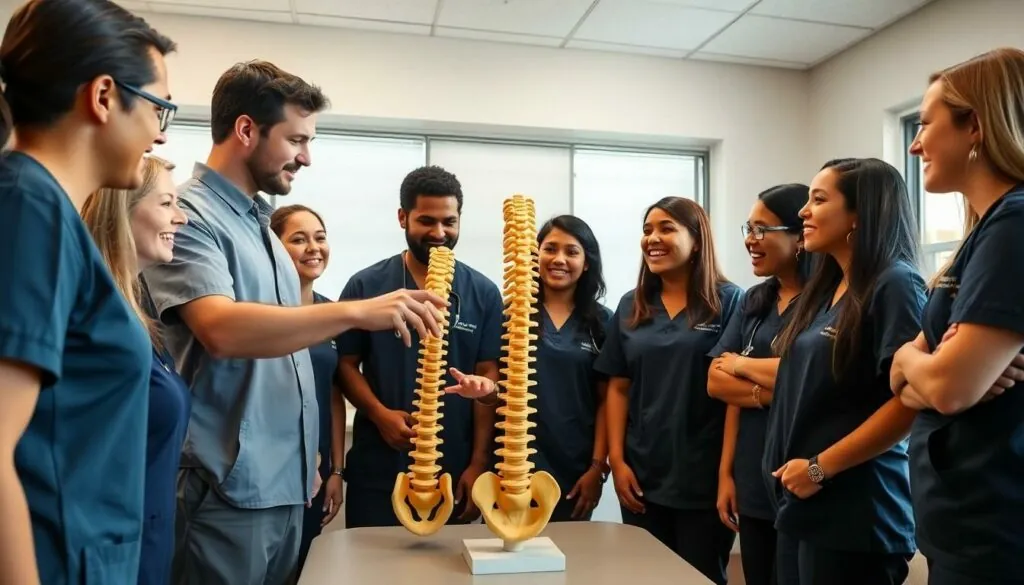Thinking about a career in chiropractic care? Palmer College of Chiropractic might just be the golden ticket you’re looking for. But before you start dreaming of adjusting spines and becoming the superhero of back pain, let’s talk dollars and cents. Tuition can feel like a mountain to climb, but fear not—understanding the costs is the first step in your journey to becoming a chiropractic wizard.
Table of Contents
ToggleOverview of Palmer College of Chiropractic Tuition
Palmer College of Chiropractic offers a comprehensive tuition structure for its Doctor of Chiropractic program. Current tuition rates stand at approximately $15,000 per year for in-state students and about $18,000 per year for out-of-state students. Each academic year includes coursework, clinics, and necessary materials, contributing to overall costs.
Students often budget for additional expenses that may arise, such as living expenses, books, and supplies. Annually, living costs can range from $10,000 to $15,000, depending on lifestyle choices and location. The total estimated cost for a three-year program can exceed $100,000, including tuition and living expenses.
Palmer College provides various financial aid options, including scholarships, grants, and loans. Specific scholarships are available to both incoming and current students, allowing individuals to reduce their financial burden. Over 90% of students receive some form of financial assistance, reflecting the college’s commitment to supporting its students.
Payment plans also exist, enabling students to manage tuition payments more effectively. Monthly payment options help ease the financial pressure, allowing for better budgeting during the academic journey. Understanding the full scope of costs associated with Palmer College of Chiropractic is crucial when planning for a career in chiropractic care.
Knowing tuition rates and available financial aid options ensures students make informed decisions about their education. Palmer College stands out for its dedication to both academic excellence and affordability.
Tuition Structure

Palmer College of Chiropractic’s tuition structure plays a significant role in the financial planning of prospective students. Understanding the cost breakdown and additional fees is crucial for managing expenses effectively.
Breakdown of Costs
In-state students face a tuition cost of approximately $15,000 per year. For out-of-state students, tuition is about $18,000 annually. Students should anticipate additional expenses, including living costs, which can range from $10,000 to $15,000. A three-year program leads to an estimated total cost exceeding $100,000. Financial aid options are available to assist students in covering these costs. Scholarships, grants, and loans received by over 90% of students can significantly alleviate financial burdens.
Additional Fees
Palmer College also charges additional fees that influence overall financial obligations. Registration fees, typically around $500, are common for every term. Laboratory fees may vary but generally cost around $900 per year. Certain courses might also require specific fees ranging from $200 to $400, depending on materials needed. Students can also expect charges for clinical rotations, which may add approximately $1,000 to $2,000 annually. Considering these additional fees helps prospective students to better prepare for their financial future.
Financial Aid Options
Palmer College of Chiropractic offers numerous financial aid options to support students in funding their education. These resources can significantly alleviate the financial burden associated with tuition and additional expenses.
Scholarships Available
Various scholarships are accessible for students at Palmer College. Merit-based scholarships reward academic excellence, while need-based scholarships focus on financial necessity. Specific awards, such as the Palmer Alumni Association Scholarship, highlight the commitment of graduates to support new students. Application processes typically require the submission of a scholarship application alongside academic records. Prospective students should explore the college’s website for detailed information about eligibility criteria and available funds.
Loan Opportunities
Multiple loan options are available to assist students in financing their education at Palmer College. Federal Direct Loans offer competitive interest rates and flexible repayment plans. Private education loans present additional avenues for borrowers who may require larger sums. Understanding the different loan types and their terms is crucial for making informed decisions. Students are encouraged to consult with the financial aid office to review personalized loan options tailored to their needs.
Comparison with Other Chiropractic Colleges
Palmer College of Chiropractic’s tuition compares favorably with other institutions in the field. For instance, Life University charges around $18,000 annually for both in-state and out-of-state students. This rate is higher than Palmer’s, especially for in-state attendees who pay about $15,000 per year.
Expenses beyond tuition also vary across chiropractic colleges. National University of Health Sciences estimates an additional $12,000 to $16,000 annually for living costs and supplies, similar to Palmer’s range. Many students face costs exceeding $100,000 for their entire program due to tuition and extra fees.
Financial aid plays a crucial role in mitigating costs. While over 90% of Palmer students receive financial assistance, other colleges report lower percentages. For example, only 70% of students at the University of Western States secure financial aid. This difference can significantly impact the affordability of education.
Specific fees further shape the financial landscape. Palmer’s laboratory fees average $900 per year, while similar institutions may charge higher rates. For instance, the Southern California University of Health Sciences typically imposes lab fees around $1,200. Registration fees at Palmer are approximately $500 per term, aligning closely with competitor charges, but clinical rotation expenses often push them above $1,500 at other colleges.
Understanding these differences helps prospective students evaluate their options. Those exploring chiropractic programs should consider tuition, additional fees, and financial aid availability. Making informed decisions is essential to ensure a manageable financial commitment in their pursuit of a chiropractic career.
Student Experiences and Testimonials
Students at Palmer College of Chiropractic often share their insights about the tuition and overall financial experience. Many express appreciation for the college’s affordability in comparison to other institutions. With in-state tuition around $15,000 per year and out-of-state fees at about $18,000, students find these rates competitive.
Financial aid plays a significant role. Over 90% of students receive some form of assistance, making education more accessible. Scholarships, grants, and loans contribute substantially to reducing the burden of tuition. Students frequently highlight the ease of navigating the available financial options, which helps manage expenses effectively.
Additional costs can vary, though many are prepared for them. Students anticipate around $10,000 to $15,000 annually for living expenses, books, and supplies. Specific fees such as registration and laboratory costs are also considered. Registration fees average $500 per term, while laboratory fees typically run about $900 per year.
Experiences during clinical rotations add another layer. Charges for clinical experiences may range from $1,000 to $2,000 annually, impacting overall financial planning. Many students appreciate the hands-on opportunities these rotations provide despite the costs.
Overall, testimonials reflect a sense of support throughout the financial journey. New and current students often encourage prospective applicants to thoroughly explore financial planning. They emphasize understanding both tuition and additional fees leads to smarter decisions regarding their educational investments at Palmer College.
Choosing Palmer College of Chiropractic can be a significant step toward a rewarding career in chiropractic care. Understanding the tuition and associated costs is vital for prospective students. With competitive rates and a strong financial aid program, many students find the support they need to manage their education expenses effectively.
As they navigate their financial commitments, it’s essential for students to consider not just tuition but also additional fees and living costs. By doing so, they can make informed decisions that align with their career goals. Palmer College stands out for its commitment to affordability and academic excellence, making it a compelling choice for aspiring chiropractors.






